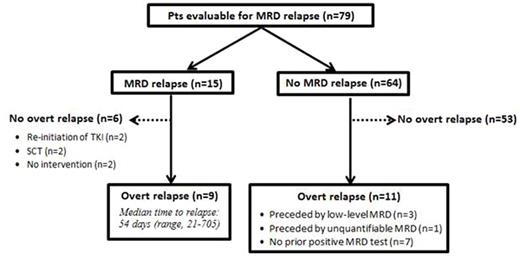Abstract
Background: Achievement of a complete molecular response (CMR) in patients (pts) with Philadelphia chromosome-positive (Ph+) acute lymphoblastic leukemia (ALL) is associated with improved survival. We sought to evaluate the patterns of molecular and overt relapse in pts who achieved CMR with chemotherapy plus a tyrosine kinase inhibitor (TKI).
Methods: We identified 164 adult pts with Ph+ ALL who received frontline hyper-CVAD plus a TKI at our institution between 4/2001 and 6/2016 and had minimal residual disease (MRD) testing after approximately 3 months of therapy; 98 pts (60%) achieved CMR and are the subject of this analysis. MRD assessment was performed using BCR-ABL1 by RQ-PCR on a remission bone marrow (BM) (sensitivity = 0.01%). CMR was defined as the absence of a quantifiable BCR-ABL1 transcript. Overt relapse was defined as recurrence of BM blasts ≥5% or CNS leukemia.MRD relapse was defined as a BCR-ABL1/ABL1 transcript level >0.01% on two occasions or one level ≥0.1%, identified in the peripheral blood or BM and in the absence of overt relapse.
Results: The median duration of follow-up was 43 months (range, 6-171 months). The TKI received was imatinib in 13 (13%), dasatinib in 46 (47%), and ponatinib in 39 (40%). 19 pts (19%) underwent allogeneic stem cell transplant (SCT) in first remission, 17 of whom were in CMR at the time of SCT. Overall 21 pts (21%) experienced overt relapse with a median time from first remission to relapse of 17 months (range 10-59 months); only 2 of these pts underwent SCT in CR1. All but 3 overt relapses occurred within 30 months of first remission; these 3 pts experienced CNS-only relapse, after 32, 46, and 59 months of remission. The median overall survival (OS) from time of overt relapse was 14 months; the 2-year OS rate was 15%.
79 pts had at least one MRD assessment after achievement of CMR and are evaluable for analysis of MRD relapse (Figure 1). Overall, 15 pts (19%) met criteria for MRD relapse. The median time from achievement of CMR to MRD relapse was 13 months (range, 2-54 months). The median OS for pts with MRD relapse was 22 months, and the 2-year OS rate was 34%.
Of the 15 pts who developed MRD relapse, 9 (60%) also developed overt relapse and 6 (40%) did not. Among the 9 pts with MRD relapse followed by overt relapse, the median time to overt relapse was 54 days (range, 21-705 days). 1 pt on dasatinib had the dose increased but overt relapse occurred 5 months after MRD relapse. In the remaining 8 pts, no preemptive treatment for MRD relapse was given. Among the 6 pts with MRD relapse who did not develop overt relapse, 2 had been off TKI therapy; upon re-initiation of a TKI, both again achieved CMR. 2 pts underwent SCT and are currently alive without overt relapse 21 and 42 months after MRD relapse, 1 pt had persistent low-level BCR-ABL1/ABL1 levels <0.1% but eventually attained CMR again without change of therapy, and 1 pt died in CR 1 month after MRD relapse.
Among 64 pts who did not develop MRD relapse, 11 (17%) experienced overt relapse. 4 of these pts had had a previous positive MRD test (i.e. BCR-ABL1/ABL1 ratio >0.01%)but not meeting criteria for MRD relapse: 3 had preceding low-level MRDon one occasion not meeting criteria for MRD relapse (ratios: 0.03, 0.07 and 0.08), and 1 had an unquantifiable positive test that preceded overt relapse. Among the 7 pts who relapsed without a prior positive MRD test, 6 experienced overt relapse with concomitant positive test for BCR-ABL1 ≥0.1% and 1 experienced BM relapse with negative PCR (though confirmed Ph+ by cytogenetics and FISH).
In 3 pts, change of TKI with or without SCT appeared to prevent overt hematologic relapse. 1 pt on dasatinib with a BCR-ABL1/ABL1 ratio of 0.08 (but not meeting criteria for MRD relapse) was given intensification of hyper-CVAD and switched to ponatinib; this pt did not undergo SCT and is still alive without overt relapse 14 months after possible MRD relapse. 2 pts on dasatinib who experienced CNS-only relapse had their TKI changed (1 to nilotinib, 1 to ponatinib) and SCT was performed. Both pts died from SCT-related complications in second CR with survival from time of MRD relapse of 22 and 19 months, respectively.
Conclusion: In pts with Ph+ ALL who achieve CMR, PCR-based monitoring of BCR-ABL1 can identify pts with MRD relapse at high risk for overt relapse and death. While various therapeutic strategies for pts who experience MRD relapse can be successful, the optimal treatment in this setting remains to be established.
Cortes:ARIAD: Consultancy, Research Funding; BMS: Consultancy, Research Funding; Novartis: Consultancy, Research Funding; Pfizer: Consultancy, Research Funding; Teva: Research Funding. O'Brien:Pharmacyclics, LLC, an AbbVie Company: Consultancy, Honoraria, Research Funding; Janssen: Consultancy, Honoraria. Jabbour:ARIAD: Consultancy, Research Funding; Pfizer: Consultancy, Research Funding; Novartis: Research Funding; BMS: Consultancy.
Author notes
Asterisk with author names denotes non-ASH members.


This feature is available to Subscribers Only
Sign In or Create an Account Close Modal